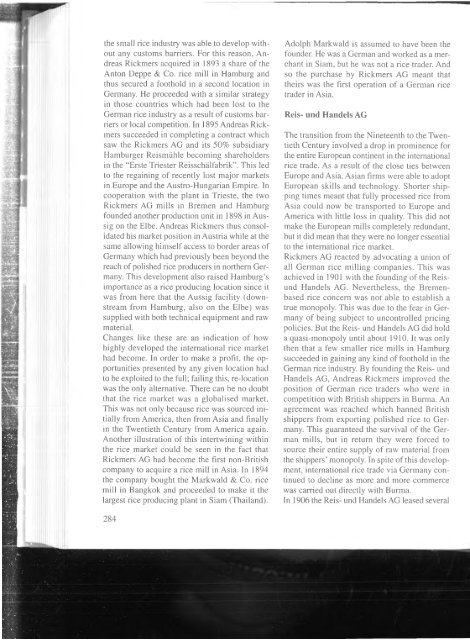Dannhauer - 2013 - Deutscher Reishandel 1850 bis 1914 die zentrale R
Dannhauer - 2013 - Deutscher Reishandel 1850 bis 1914 die zentrale R
Dannhauer - 2013 - Deutscher Reishandel 1850 bis 1914 die zentrale R
You also want an ePaper? Increase the reach of your titles
YUMPU automatically turns print PDFs into web optimized ePapers that Google loves.
ш<br />
the small rice industry was able to develop without<br />
any customs barriers. For this reason, Andreas<br />
Rickmers acquired in 1893 a share of the<br />
Anton Deppe & Co. rice mill in Hamburg and<br />
thus secured a foothold in a second location in<br />
Germany. He proceeded with a similar strategy<br />
in those countries which had been lost to the<br />
German rice industry as a result of customs barriers<br />
or local competition. In 1895 Andreas Rickmers<br />
succeeded in completing a contract which<br />
saw the Rickmers AG and its 50% subsidiary<br />
Hamburger Reismühle becoming shareholders<br />
in the “Erste Triester Reisschälfabrik”. This led<br />
to the regaining of recently lost major markets<br />
in Europe and the Austro-Hungarian Empire. In<br />
cooperation with the plant in Trieste, the two<br />
Rickmers AG mills in Bremen and Hamburg<br />
founded another production unit in 1898 in Aussig<br />
on the Elbe. Andreas Rickmers thus consolidated<br />
his market position in Austria while at the<br />
same allowing himself access to border areas of<br />
Germany which had previously been beyond the<br />
reach of polished rice producers in northern Germany.<br />
This development also raised Hamburg’s<br />
importance as a rice producing location since it<br />
was from here that the Aussig facility (downstream<br />
from Hamburg, also on the Elbe) was<br />
supplied with both technical equipment and raw<br />
material.<br />
Changes like these are an indication of how<br />
highly developed the international rice market<br />
had become. In order to make a profit, the opportunities<br />
presented by any given location had<br />
to be exploited to the full; failing this, re-location<br />
was the only alternative. There can be no doubt<br />
that the rice market was a globalised market.<br />
This was not only because rice was sourced initially<br />
from America, then from Asia and finally<br />
in the Twentieth Century from America again.<br />
Another illustration of this intertwining within<br />
the rice market could be seen in the fact that<br />
Rickmers AG had become the first non-British<br />
company to acquire a rice mill in Asia. In 1894<br />
the company bought the Markwald & Co. rice<br />
mill in Bangkok and proceeded to make it the<br />
largest rice producing plant in Siam (Thailand).<br />
Adolph Markwald is assumed to have been the<br />
founder. He was a German and worked as a merchant<br />
in Siam, but he was not a rice trader. And<br />
so the purchase by Rickmers AG meant that<br />
theirs was the first operation of a German rice<br />
trader in Asia.<br />
Reis- und Handels AG<br />
The transition from the Nineteenth to the Twentieth<br />
Century involved a drop in prominence for<br />
the entire European continent in the international<br />
rice trade. As a result of the close ties between<br />
Europe and Asia, Asian firms were able to adopt<br />
European skills and technology. Shorter shipping<br />
times meant that fully processed rice from<br />
Asia could now be transported to Europe and<br />
America with little loss in quality. This did not<br />
make the European mills completely redundant,<br />
but it did mean that they were no longer essential<br />
to the international rice market.<br />
Rickmers AG reacted by advocating a union of<br />
all German rice milling companies. This was<br />
achieved in 1901 with the founding of the Reisund<br />
Handels AG. Nevertheless, the Bremenbased<br />
rice concern was not able to establish a<br />
true monopoly. This was due to the fear in Germany<br />
of being subject to uncontrolled pricing<br />
policies. But the Reis- und Handels AG did hold<br />
a quasi-monopoly until about 1910. It was only<br />
then that a few smaller rice mills in Hamburg<br />
succeeded in gaining any kind of foothold in the<br />
German rice industry. By founding the Reis- und<br />
Handels AG, Andreas Rickmers improved the<br />
position of German rice traders who were in<br />
competition with British shippers in Burma. An<br />
agreement was reached which banned British<br />
shippers from exporting polished rice to Germany.<br />
This guaranteed the survival of the German<br />
mills, but in return they were forced to<br />
source their entire supply of raw material from<br />
the shippers’ monopoly. In spite of this development,<br />
international rice trade via Germany continued<br />
to decline as more and more commerce<br />
was carried out directly with Burma.<br />
In 1906 the Reis- und Handels AG leased several

















